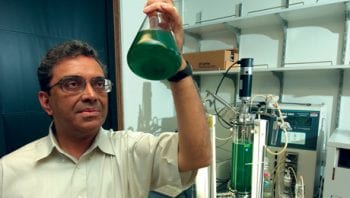Washington University is reducing its environmental impact while developing new research and initiatives aimed at forging a more sustainable future.

University faculty, staff, and students collaborate on a variety of academic endeavors that contribute to rapid progress in addressing the major environmental and public health challenges facing our planet. Learn more about our sustainability research and educational initiatives below.
Initiatives
The vision for the Center for the Environment is to mobilize the research and creative capacity of Washington University and the strength of interdisciplinary partnerships to advance knowledge that addresses complex environmental challenges.
Tyson Research Center is the university’s 2000-acre ecological field station, located 30 minutes west of the Danforth Campus. The largely forested campus includes dozens of buildings and site lighting that draw electricity from the grid. With the 2014 addition of a 50 kilowatt ground-mounted solar array, the entire Tyson campus is one-third of the way to being net-zero energy, earning recognition by the EPA’s Green Power Partnership. Tyson has a long track record of excellence in sustainable operations, with the first Living Building Challenge-certified building in the world, the university’s only geothermal system, and a new 20,000-gallon rain water harvesting system added in 2014. The new solar array brings the Tyson campus’s total to 73 kw of solar PV.
The Living Earth Collaborative at Washington University in St. Louis is dedicated to advancing the knowledge of biodiversity and to ensuring the future of earth’s species in their many forms.
The center was launched in early 2018 under the direction of Jonathan Losos. Washington University, the Missouri Botanical Garden and the Saint Louis Zoo are working in partnership to advance the center’s mission.